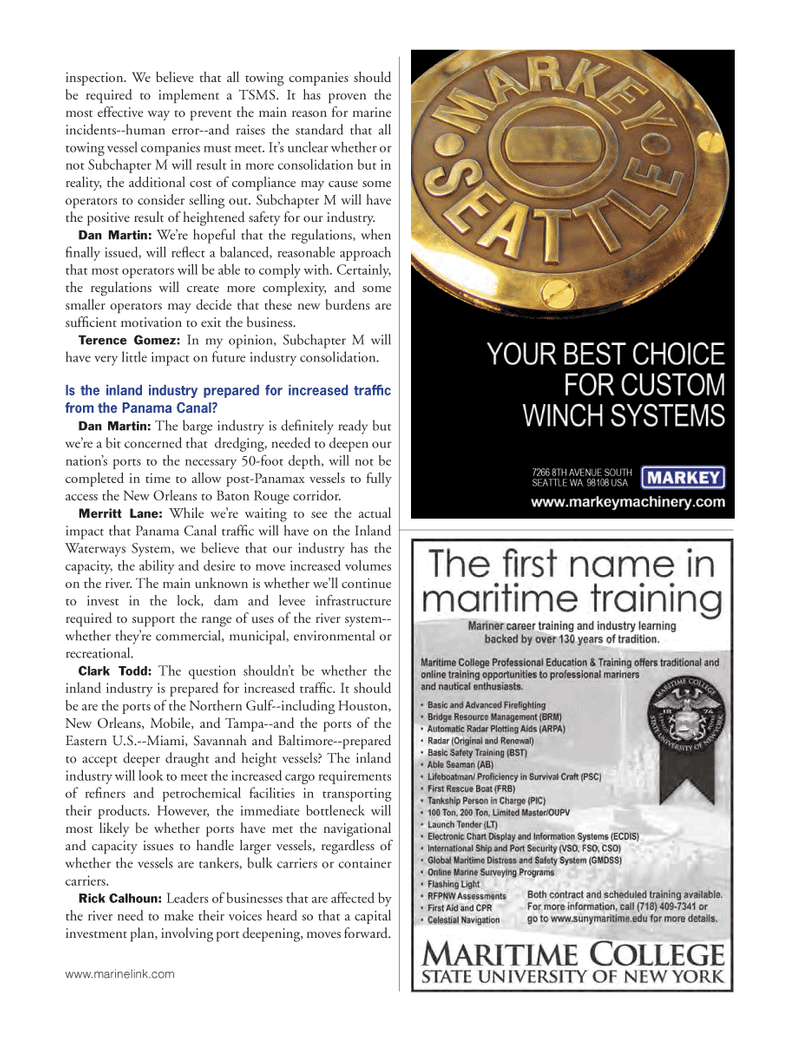
Page 29: of Marine News Magazine (February 2013)
Bulk Transport Leadership Roundtable
Read this page in Pdf, Flash or Html5 edition of February 2013 Marine News Magazine
inspection. We believe that all towing companies should be required to implement a TSMS. It has proven the most effective way to prevent the main reason for marine incidents--human error--and raises the standard that all towing vessel companies must meet. It?s unclear whether or not Subchapter M will result in more consolidation but in reality, the additional cost of compliance may cause some operators to consider selling out. Subchapter M will have the positive result of heightened safety for our industry. Dan Martin: We?re hopeful that the regulations, when nally issued, will re ect a balanced, reasonable approach that most operators will be able to comply with. Certainly, the regulations will create more complexity, and some smaller operators may decide that these new burdens are suf cient motivation to exit the business. Terence Gomez: In my opinion, Subchapter M will have very little impact on future industry consolidation. Is the inland industry prepared for increased trafÞ c from the Panama Canal? Dan Martin: The barge industry is de nitely ready but we?re a bit concerned that dredging, needed to deepen our nation?s ports to the necessary 50-foot depth, will not be completed in time to allow post-Panamax vessels to fully access the New Orleans to Baton Rouge corridor. Merritt Lane: While we?re waiting to see the actual impact that Panama Canal traf c will have on the Inland Waterways System, we believe that our industry has the capacity, the ability and desire to move increased volumes on the river. The main unknown is whether we?ll continue to invest in the lock, dam and levee infrastructure required to support the range of uses of the river system-- whether they?re commercial, municipal, environmental or recreational. Clark Todd: The question shouldn?t be whether the inland industry is prepared for increased traf c. It should be are the ports of the Northern Gulf--including Houston, New Orleans, Mobile, and Tampa--and the ports of the Eastern U.S.--Miami, Savannah and Baltimore--prepared to accept deeper draught and height vessels? The inland industry will look to meet the increased cargo requirements of re ners and petrochemical facilities in transporting their products. However, the immediate bottleneck will most likely be whether ports have met the navigational and capacity issues to handle larger vessels, regardless of whether the vessels are tankers, bulk carriers or container carriers.Rick Calhoun: Leaders of businesses that are affected by the river need to make their voices heard so that a capital investment plan, involving port deepening, moves forward. www.marinelink.com MN Feb2013 Layout 18-31.indd 29MN Feb2013 Layout 18-31.indd 291/30/2013 4:49:53 PM1/30/2013 4:49:53 PM

 28
28

 30
30
